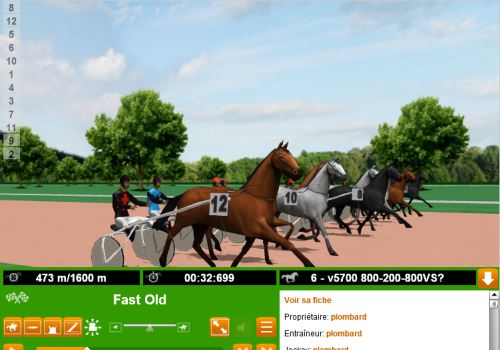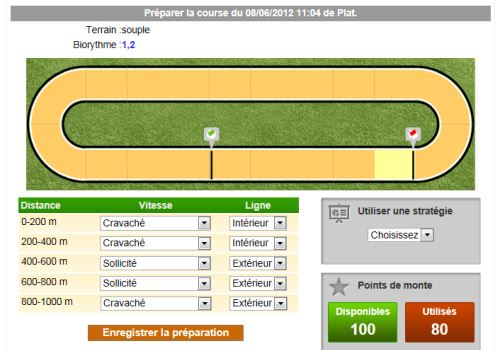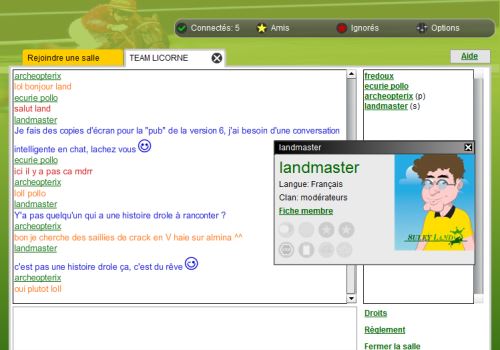Tutoriel: bien démarrer sur Sulkyland
Sulkyland is a virtual horse racing game, so the first step to understand the game mechanisms is to have your own horse.
Create a horse
Click on the menu "Owner" then click on the link "Create a horse".
You reach the following page :

Just choose the basic characteristics of a horse : his name, age (1 to 4 years old), sex (male or female), speciality (flat, hurdle or trot) and his coat color (black, white, bay or chestnut).
Then click on the button "Create this horse", you are led to the page "Owner" - "My horses" which shows you the list of your horses.

Entering a race
Now that you have a horse, you can enter a race. You only need to click on the button in the column "Next race". This opens a new window with the list of the races that your horse can run.

The column "Cost/Price/Level" indicates to you the amount you have to pay to enter the race, the sum that will be shared between the winners of the race, and the number of horses who have to enter to make the race profitable to its organizer. If the level is low (i.e. 3, you should avoid the race), look for a better one. If the level is high, it's more interesting financially for you. If the level is "Automatic", this means that the earnings are proportional to the number of runners.
The entering cost is in sulkies, the virtual currency of the game. As you have just registered, you only have 4000 sulkies in your portfolio, so you need to search a race that costs less than 4000 sulkies.
The column " Entrants/Minimum/You/Maxi" indicates to you the number of horses already enrolled in the race, the minimal number of entrants required by the race to be run, the number of horses you already enrolled in this race (currently 0) and the maximum number of horses you can enroll (you can enroll several horses at a race, this is not forbidden). Search for a race where the number of registrations is higher than the minimum, like that you will see the result of the race fast.
The column "Class" gives you the quality of the race. "Free" races can be a trap to beginners who should avoid them. "Competition" races are top-of-the-range, they won't give you a chance at the beginning. So we recommend you to choose "reglementary" races.
When you found a race you like, click on the button at the right to send your entering request. If everything works, you should see the following message :

Defining a racing strategy
Now click on the link "Click here" to go to the page where you can prepare your racing strategy.
The new window is like that one :

Defining your racing strategy consists in making choices in the column "Speed" and "Line" of the table.
With the speed "unprompted", your horse doesn't get tired. When he's at another speed, he draws on his resistance to maintain the chosen speed. So your strategy consists in pushing your horse to his limits, without exceeding them, because if you push him too much he will "succumb" and finish the race in slow-motion.
The resistance your horse can use is mainly defined by his genetics, and by his biorhythm too. The calculator of "whip points" helps you to estimate the potential of your horse with more or less 5 to 10 points (it depends on biorhythm, when it's positive it gives you a bonus and when it's negative a penalty). According to the chosen speed for each 100m of race, you use between 2.5 and 10 whip points.
The "line" strategy sets your position on the racetrack. "Internal" means near the rail, that's to say at the left of the track. "External" means far of the rail (this line gives you a better chance to overtake without being disturbed by another horse). The "middle" is an intermediary situation.
Select 400m in the column "until", a second line appears for the last section of 1000m of the race. Enter "Whipped" for this second section. You see the number of "whip point" raising. Adjust the value of the 1st "until" to bring the total of your whip points closer to those indicated by the calculator, then adjust the speed of the 2nd line to obtain exactly the number of whip points available (or stay under this number if you can't equal it). In our example of a 1400m race, this would be "prompted" from 0 to 400m then "whipped" for the remaining distance.
The picture under the preparation area symbolize the form of the racetrack and the chosen strategy. Go to the chapter "Jockey" to get details on the way of using it.
Click on "Save the preparation" to finish.
While waiting for the race to be run, we will see in the next chapter how to train a horse.








